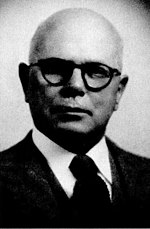Laurence I. Hewes

No one man contributed more to the development of the highways of the West than Dr. Laurence Ilsley Hewes. He opened the Western Headquarters Office of the Bureau of Public Roads in 1921 when Washington officials felt that the magnitude of the national forest highways and the expected increased workload resulting from the 1921 Federal Highway Act needed more direct supervision than was possible by having all review authority placed in Washington. In the course of his 29-year tenure, he stimulated and guided highway progress over an area representing one-third of the Nation.
Dr. Hewes was born in New Hampshire. He received a B.S. degree from Dartmouth College in 1898 and a Ph.D. from Yale University in 1901. He then taught science and mathematics at Rhode Island State College, Yale University and Whitman College, Walla Walla, Washington. In 1911 he was appointed as a Senior Highway Engineer with the Federal Office of Public Roads in Washington, D.C.
In 1920, as General Inspector, he conducted a study of the operations of the California Highway Commission and of its accomplishments under three State highway bond issues. The report was cited as being the most comprehensive study of results obtained through the development of a State highway system that had yet been undertaken. In fact, this report was the initial highway needs study of the type later authorized under Section 11 of the 1934 Hayden-Cartwright Act, which authorized Federal-aid funds to cover the cost of highway planning surveys.
Dr. Hewes was selected in 1921 to administer the Federal-aid highways and the direct Federal highway construction programs in the 11 western States and the Territories of Alaska and Hawaii. He served continuously as chief of the Western Headquarters for almost 30 years.
During that time, Dr. Hewes guided and shaped the highway transportation patterns of the Federal-aid highway system. He assured the connection of Federal-aid road systems in the West with the principal roads of Canada and Mexico and with Federal-aid routes of the States to the east. He directed the construction of thousands of miles of Federal roads and trails through the national forests and parks. He directed the coordinated efforts of Public Roads and the western States leading to the designation of the city-to-city routes of the National System of Interstate and Defense Highways. He also directed the activities leading to the designation of the Federal-Aid Secondary Road System and Federal-aid route extensions through the urban areas in the West that were authorized in the 1944 Highway Act.
As an engineer, controller, expediter and manager, Dr. Hewes had an influence on every phase of highway construction. “The problem of keeping a high mountain pass free from winter blockade in Colorado was as fascinating problem to him as repairing flood damage on an Oregon valley road, or the threat of shifting sands to travel in the Imperial Valley,” according to a testimonial written after his death.
His interest in keeping the Federal-State partnership active and healthy led him to play a major role in the establishment of the Western Association of State Highway Officials (consisting of the 11 western States, Alaska, Hawaii, Texas, and the Forest Service, Park Service, Land Management and Public Roads agencies). He participated in all of its meetings and in the work of its various committees.
In addition, Dr. Hewes contributed many technical and policy papers dealing with highways. He authored several books on mathematics and highway engineering, the most important of which was American Highway Practice, a standard engineering reference first published in 1942. In collaboration with Professor Clark Oglesby of Stanford University, he published several revised editions.
In 1934 Dr. Hewes was Chairman of the American Delegation to the Seventh International Roads Congress at Munich, Germany. In 1946–47 he was Consulting Engineer to the government of Saudi Arabia.
490
